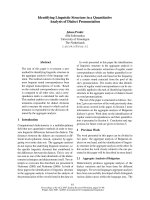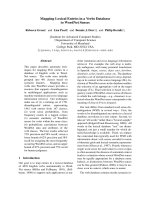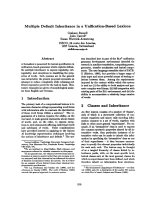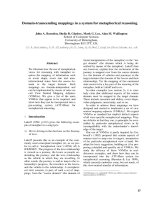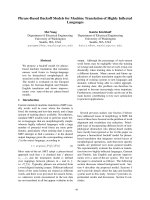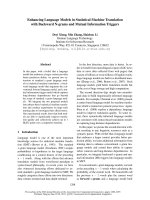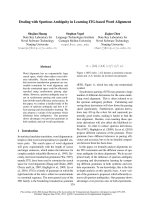Báo cáo khoa học: "DEALING WITH CONJUNCTIONS IN A MACHINE TRANSLATION ENVIRONMENT" pptx
Bạn đang xem bản rút gọn của tài liệu. Xem và tải ngay bản đầy đủ của tài liệu tại đây (326.17 KB, 4 trang )
DEALING WITH CONJUNCTIONS
IN A MACHINE TRANSLATION ENVIRONMENT
Xiumlng HUANG
Institute of Linguistics
Chinese Academy of Social Sciences
BeiJing, China*
ABSTRACT
The paper presents an algorithm, written in
PROLOG, for processing English sentences which
contain either Gapping, Right Node Raising (RNR)
or Reduced Conjunction (RC). The DCG (Definite
Clause Grammar) formalism (Pereira & Warren 80) is
adopted. The algorithm is highly efficient and
capable of processing a full range of coordinate
constructions containing any number of coordinate
conjunctions ('and', 'or', and 'but'). The
algorithm is part of an English-Chinese machine
translation system which is in the course of
construction.
0 INTRODUCTION
Theoretical linguists have made a
considerable investigation into coordinate
constructions (Ross 67a, Hankamer 73, Schachter
77, Sag
77,
Gazdar 81 and Sobin 82, to name a
few), giving descriptions of the phenomena from
various perspectives. Some of the descriptions are
stimulating or convincing. Computational
linguists, on the other hand, have achieved less
than their theoretical counterparts.
(Woods 73)'s SYSCONJ, to my knowledge, is the
first and the most often referenced facility
designed specifically for coordinate construction
processing. It can get the correct analysis for
RC sentences like
(i) John drove his car through and
completely demolished a plate glass window
but only after trying and failing an indefinite
number of times, due to its highly non-
deterministic nature.
(Church 79) claims '~ome impressive initial
progress" processing conjunctions with his NL
parser YAP. Using a Marcus-type attention shift
mechanism, YAP can parse many conjunction
constructions including some cases of Gapping.
It doesn't offer a complete solution to
conjunction processing though: the Gapping
sentences YAP deals with are only those wlth two
NP remnants in a Gapped conjunct.
* Mailing address: Cognitive Studies Centre,
University of Essex,
Colchester C04 3SQ, England.
(McCord 80) proposes a "more straightforward
and more controllable" way of parsing sentences
like (I) within a Slot Grammar framework. He
treats "drove his car through and completely
demolished" as a conjoined VP, which doesn't seem
quite valid.
(Boguraev 83) suggests that when "and" is
encountered, a new ATN arc be dynamlcally
constructed which seeks to recognise a right hand
constituent categorlally similar to the left hand
one just completed or being currently processed.
The problem is that the left-hand conjunct may not
be the current or most recent constituent hut the
constituent of which that former one is a part.
(Berwlck 83) parses successfully Gapped
sentences like
(2) Max gave Sally a nickel yesterday, and a
dime today
using an extended Marcus-type deterministic
parser. It is not clear, though, how his parser
would treat RC sentences llke (I) where the fi~t
conjunct is not a complete clause.
The present work attacks the coordinate
construction problem along the lines of DCG. Its
coverage is wider
than
the existing systems: both
Gapping, RNR and RC, as well as ordinary cases of
coordinate sentences, are taken into
consideration. The work is a major development of
(Huang 83)'s CASSEX package, which in turn was
based on (Boguraev 79)'s work, a system for
resolving linguistic ambiguities which combined
ATN grammars (Woods 73) and Preference Semantics
(Wilks 75).
In the first section of the paper, problems
raised for Natural Language Processing by Gapping,
RNR and RC are investigated. Section 2 gives a
grouping of sentences containing coordinate
conjunctions. Finally, the algorithm is described
in Section 3.
I GAPPING, RIGHT NODE RAISING AND
REDUCED CONJUNCTION
I.I Gapping
Gapping is the case where the verb or the
verb together with some other elements in the
non-leftmost conjuncts is deleted from a sentence:
(3) Bob saw Bill and Sue [saw] Mary.
243
(4) Max wants to try to begin to write a
novel, and Alex [wants to try to begin to write] a
play.
Linguists have described rules for generating
Gapping, though none of them has made any effort
to formulate a rule for detecting Gapping. (Ross
67b) is the first who suggested a rule for
Gapping. The formalisation of the rule is due to
(Hankamer 73):
Gap pl ng
NP X A Z and NP X B Z > NP X A Z and NP B
where A and B are nonidentical major
constituents*.
(Sag 76) pointed out that there were cases
where the left peripheral in the right conjunct
might be a non-NP, as in
(5) At our house, we play poker, and at
Betsy's house, bridge.
It should be noted that the two NPs in the
Gapping rule must not be the same, otherwise (7)
would be derived from (6):
(6) Bob saw Bill and Bob saw Mary.
(7) Bob saw Bill and Bob Mary.
whereas people actually say
(8) Bob saw Bill and Mary.
When processing (8), we treat it as a simplex
containing a compound object ("Bill and Mary")
functioning as a unit ("unit interpretation"),
although as a rule we treat sentence containing
conjunction as derived from a "complex", a
sentence consisting of more than one clause, in
this case "Bob saw Bill and Bob saw Mary"
("sentence coordination interpretation"). The
reason for analysing (8) as a simplex is first,
for the purpose of translation, unit
interpretation is adequate (the ambiguity, if any,
will be "transferred" to the target language);
secondly, it is easier to process.
Another fact worth noticing is that in the
above Gapping rule, B in the second conjunct could
be anything, but not empty. E.g., the (a)s in the
following sentences are Gapping examples, but the
(b)s are not:
(9) (a) Max spoke fluently, and Albert
haltingly.
*(b) Max spoke fluently, and Albert.
(I0) (a) Max wrote a novel, and Alex a
play.
*(b) Max wrote a novel, and Alex.
(II) (a) Bob saw Bill, and Sue Mary.
(b) Bob saw Bill, and Sue.
Before trying to draw a rule for detecting
* According to the dependency grammar we adopt, we
define a major constituent of a given sentence S
as a constituent immediately dominated by the main
verb of S.
Gapping, we will observe the difference between
(12) and (13) on one hand, and (14) on the other:
(12) Bob met Sue and Mar k in London.
(13) I knew the man with the telescope
and the woman with the umbrella.
(14) Bob met Sue in Paris and Mary in London.
As we stated above, (12) is not a case of Gapping;
instead, we take "Sue and Mary" as a coordinate
NP. Nor is (13) a case of Gapping. (14), however,
cannot be treated as phrasal coordination because
the PP in the left conjunct ("in Paris") is
directly dominated by the main verb so that "Mary"
is prevented from being conjoined to "Sue".
Now, the Gapping Detecting Rule:
The structure "NPI V A X and NP2 B" where the
left conjunct is a complete clause, A and B are
major constituents, and X is either NIL or
a constituent not dominated by A, is a case of
Gapping if (OR (AND (X = NIL) (B = NP))
(AND (V = 3-valency verb)*
(OR (B = NP) (B = to NP)))
(AND (X /= NP) (X /= NIL)))**
1.2 Right Node Raising (RNR)
RNR is the case where the object in the non-
rightmost conjunct is missing.
(15) John struck and kicked the boy.
(16) Bob looked at and Bill took the jar.
RNR raises less serious problems than Gapping
does. All we need to do is to parse the right
conjunct first, then copy the object over to the
left conjunct so that a representation for the
left clause can be constructed. Then we combine
the two to get a representation for the sentence.
Sentences llke the following may raise
difficulty for parsing:
(17) I ate and you drank everything they
brought. (cf. Church 79)
(17) can be analysed either as a complex of two
full clauses, or RNR, according to whether we
treat '~te" as transitive or intransitive.
1.3 Reduced Conjunction
Reduced Conjunction is the case where the
conjoined surface strings are not well-formed
constituents as in
(18) John drove his car through and completely
demolished a plate glass window.
where the conjoined surface strings "drove his car
through" and "completely demolished" are not well-
formed constituents. The problem will not be as
* 3-valency verbs are those which can appear in
the structure "NP V NP NP', such as "give',
"name', "select', 'call', etc.
** Here "/=" means "is not".
244
serious as might have seemed, given our
understanding of Gapping and RNR. After we
process the left conjunct, we know that an
object is still needed (assuming that "through" is
a preposition). Then we parse the right
conjunct, copying over the subject from the left;
finally, we copy the object from the right
conjunct to the left to complete the left clause.
II GROUPING OF SENTENCES CONTAINING CONJUNCTIONS
We can sort sentences containing conjunctions
into three major groups on the basis of the nature
of the left-most conjunct: Group A contains
sentences whose left-most conjuncts are recognized
by the analyser as complete clauses; Group B, the
left-most conjuncts are not complete clauses, but
contain verbs; and Group C, all the other cases.
The following is a detailed grouping with example
sentences:
AI. (Gapping) Clause-lnternal ellipsis:
(19) I played football and John tennis.
(20) Bob met Sue in Paris and John Mary in
London.
(21) Max spoke fluently and Albert
haltingly.
A2. (Capping) Left-peripheral ellipsis wlth two
NP remnants:
(22) Max gave a nickel to Sally and a dime
to Harvey.
(23) Max gave Sally a nickel and Harvey a
dime.
(24) Jack calls Joe Mike and Sam Harry.
A3. (Gapping)Left-perlpheral ellipsis with one NP
remnant and some non-NP remnant(s):
(25) Bob met Sue in Paris and Mary In
London.
(26) John played football yesterday and
tennis today.
A4. (Gapping) Right-perlpheral ellipsis
concomitant with clause-internal elllpsls:
(27) Jack begged Elsie to get married and
Wilfred Phoebe.
(2~) John persuaded Dr. Thomas to examine
Mary, and Bill Dr. Jones.
(29) Betsy talked to Bill on Sunday, and
Alan to Sandy.
A5.
The
right conjunct is a complete clause:
(30) I played football and John watched the
television.
A6. The right conjunct is a verb phrase to be
treated as a clause with the subject deleted:
(31) The man kicked the child and threw the
ball.
AT. Sentences where the "unit interpretation"
should be taken:
(32) Bob met Sue and Mary in London.
(33) I knew the glrl bitten by the dog and
the cat.
BI. Right Node Raising:
(34) The man kicked and threw the ball.
(35) The man kicked and the woman threw the
ba I 1.
B2. Reduced Conjunction:
(36) John drove hls car through and
completely demolished a plate glass
window.
C. Unlt interpretations:
(37) The man with the telescope and the woman
with the umbrella kicked the ball.
(38) Slowly and stealthily, he crept towards
his victim.
III THE ALGORITHM
The following algorithm, implemented in
PROLOG Version 3.3 (shown here in much abridged
form), produces correct syntactlco-semantic
representations for all the sentences given in
Section 2. We show here some of the essential
clauses* of the algorithm: "sentence',
"rest sentencel" and "sentence conjunction'. The
top-most clause "sentence" parses sentences
consisting of one or more conjuncts. In the body
of "sentence', we have as sub-goals the
disjunction of "noun_phrase" and 'noun phrasel',
for getting the sentence subject; the disjunction
of "[W], Is verb" and 'verbl', plus 'rest verb',
for treating the verb of the sentence; the
disjunction of 'rest sentence" and "rest
sentence1" for handling The object, preposltlonaT
phrases, etc; and finally "sentence conJunctlon',
for handling coordinate conjunctlon~
The Gapping, RNR and RC sentences In Section
II contain deletions from either left or right
conjuncts or both. Deleted subjects in right
conjuncts are handled by 'noun phrasel' in our
program; deleted verbs in right conjuncts by
'verbl'. The most difficult deletions to handle
(for previous systems) are those from the left
conjuncts, ie. the deleted objects of RNR (Group
BI) and the deleted preposition objects of RC
(Group B2), because when the left conJuncts are
being parsed, the deleted parts are not avallabl~
This is dealt with neatly in PROLOG DCG by using
logical variables which stand for the deleted
parts, are "holes" In the structures built, and
get filled later by unification as the parsing
proceeds.
sentence(Stn, P Sub j, P Subj Head Noun, P Verb,
P V Type, P Contentverb, P Tense,
P~Ob-j,
PObJH~dNoun) >
% P means "possible": P arguments only
% ~ve values if "sentenCe' is called by
% 'sentence_conjunctlon' to parsea second
% (right) conjunct. Those values will be
% carried over from the left conjunct.
(noun phrase(Sub J,
HeadNoun);
noun phrasel (P Sub J, P SubJ Head Noun, Sub J,
HeadNoun) ),
% "noun_phrasel" copies over the subject
% from the left conjunct.
adve rblal_phrase (Adv),
([w],
% W is the next lexlcal item.
is_verb(W, Verb, Tense) ;
% Is W a verb?
verbl(P_Verb, Verb, PContentverb, Contentverb,
P Tense, Tense, P_VType, VType)),
"verb1" copies over the verb from the
% left conjunct.
* A "clause" in our DCG comprises a head (a single
goal) and a body (a sequence of zero or more
goal
s
).
245
rest verb(Verb ,Tense,Verbl,Tensel),
'rest verb" checks whether Verb is an
% auxi~ary.
(rest sentence(dcl,Subj,Head Noun,Verbl, VType,
Co~tentverb,Tensel ,Obj, O~j_.Head_Noun, P__ObJ,
P Obj Head Noun, Indobj, S);
% "rest sentence" handles all cases but RC.
rest sentence I (d cl, SubJ, HeadNoun, Verb I, VType,
C~ntentverb,Tensel, Obj, Obj_Head_Noun,
P ObJ, P_.Obj_.Head._Noun, Indobj, S)),
"rest sentencel" handles RC.
sentence_.co~junctlon(S, Stn, Sub j, HeadNoun,
Verbl, V_Type, Contentverb, Tensel, Obj,
ObjHeadNoun ) •
rest sentence I (Type, Sub j, Head_Noun, Verbl, VType,
~ontentver5, Tense, Prep ObJ,Prep ObJHead
Noun, P_Obj, P ObJ Head Noun, Indobj,
s(type(Type), tense(Tense), v(Verb sense,
agent(Subj), object(Obj), pos t ve rb_
mods(prep(Prep), pre~obj(Prep_Obj)))Y >
% Here Prep ObJ is a logical variable which
%will be Instantlated later when the
% right conjunct has been parsed.
{verb type(Verb, VType)},
comp~ement(V Type, Verb, Contentverb, Sub j,
Head Noun, Obj, Obj_Head Noun, P Obj,
P_Ob~_Head_Noun, v(Verb sense, agent(~ubj),
object(Oh j), post_v~rb_mods(prep(W),
pr ep_obJ ( Pr ep_.Obj ) ) ),
% The sentence object is processed and the
% verb structure built here.
[w],
{prepositlon(W) }.
sentence_.conjunction(S,s(conj(W), S, Sconj), Sub j,
Head Noun, Verbl, VType, Verb2, Tense, Obj,
Obj ~ead Noun) >
([" ]. [wT; [w]),
{conj(W)},
% Checks whether W is a conjunction.
sentence(Sconj, Subj, Head Noun, Verbl, V_Type,
Verb2, Tense, 0bj, 0bjHe~dNoun).
% "sentence" is called recursively to parse
% right conjuncts.
sentence conjunction(S, S, _, _, _, _, _, _, _, _)
> ]]. % Boundary condition.
For sentence (36) ("John drove his car
through and completely demolished a plate glass
window"), for instance, when parsing the left
conjunct, "rest sentencel" will be called event-
ually. The follo~ing verb structure will be built:
v(drovel ,agent(np(pronoun(John))), object(np(det
(his), pre mod([]), n(carl), post mods([]))), post
verbmods~prep mods ( prep ( through~, pre~obJ (Prep
Obj)), where th[ logical variable PrepObJ will be
unified later with the argument standing for the
object in the right conjunct (ie, "a plate glass
window"). When 'sentence" is called via the sub-
goal 'sentence_conjunctlon" to process the right
conjunct, the deleted subject "John" will be
copied over via "noun phrasel'. Finally a
structure is built which i-s a combination of two
complete clauses. During the processing little
effort is wasted. The backward deleted consti-
tuents ("a plate glass window" here) are recovered
by using logical variables; the forward deleted
ones ("John" here) by passing over values (via
unification) from the conjunct already processed.
Moreover, the "try-and-fail" procedure is carried
out in a controlled and intelligent way. Thus a
high efficiency lacking in many other systems is
achieved (space prevents us from providing a
detailed discussion of this issue here).
ACKNOWLEDGEME NTS
I would llke to thank Y. Wilks, D. Arnold,
D. Fass and C. Grover for their comments and
instructive discussions. Any errors are mine.
BIBLIOGRAPHY
Berwlck, ~ C. (1983) "A deterministic parser with
broad coverage." Bundy, A. (ed),
Proceedings of IJCAI 83, William Kaufman, Inc.
Boguraev, B. K. (1979) Automatic Resolution of
Linguistic Ambiguities. Technical Report No. II,
University of Cambridge Computer Laboratory,
Cambridge.
Boguraev, B. K. (1983) "Recognlslng conjunctions
withing the ATN framework." Sparck-Jones, ~ and
Wilks, Y. (eds), Automatic Natural Language
Parsing, Ellis Horwood.
Church, K. W. (1980) On Memory Limitations in
Natural Language Processing. MIT.
Reproduced by Indiana Univ. Ling. Club,
Bloomingtong, 1982.
Gazdar, G. (1981) "Unbounded dependencies and
coordinate structure," Linguistic Enquiry, 12:
155 - 184.
Hankamer, J. (1973) "Unacceptable ambiguity,"
Lingulstic Inquiry, 4: 17-68.
Huang, X-M. (1983)"Dealing with conjunctions in a
machine translation environment," Proceedings
of the Association for Computational Linguistics
European Chapter Meeting, Pisa.
McCord, M. C. (1980) "Slot grammars," American
Journal of Computational Linguistics, 6:1,31-43.
Perelra, F. & Warren, D. (1980)"Definite clause
grammars for language analysis - a survey of the
formalism and a comparison with augmented
transition networks," Artificial Intelllgence,
13:231 - 278.
Ross, J. R. (1967a) Constraints on Variables in
Syntax. Doctoral Dissertation, MIT,Cambridge,
Massachusetts. Reproduced by Indiana Univ. Ling.
Club, Bloomington, 1968.
Ross, J. R. (1967b) "Gapping and the order of
constituents," Indiana Univ. Ling. Club,
Bloomington. Also in Bierwisch, M. and K.
Heidolph, (eds), Recent Developments i__nn
Linguistics, Mouton, The Hague, 1971.
Sag, I. A. (1976) Deletion and Logical Form. Ph.D.
thesis, MIT, Cambridge, Mass.
Schachter, P. (1977) "Constraints on
coordination," Language, 53:86 - 103.
Sobin, N. (1982) "On gapping and discontinuous
constituent structure," Linguistics,20:727-745.
Wilks, Y. A. (1975) "Preference Semantics," Keenan
(ed), Formal Semantics of Natural Language,
Cambridge Univ. Press, London.
Woods, W. ~ (1973)"A experimental parsing system
for Transition Network Grammar," Rustin,
(ed), Natural Language Processing, Algorithmic
Press, N. Y.
246

